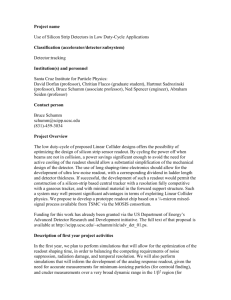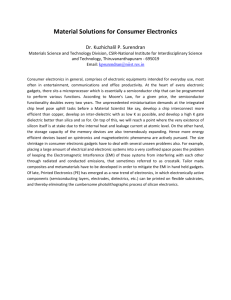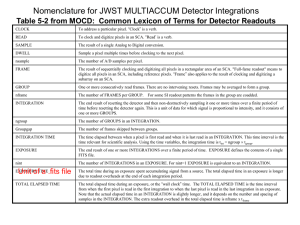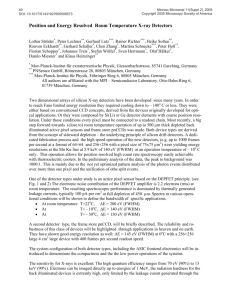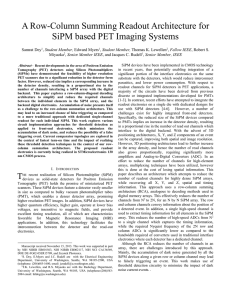e - Cern
advertisement
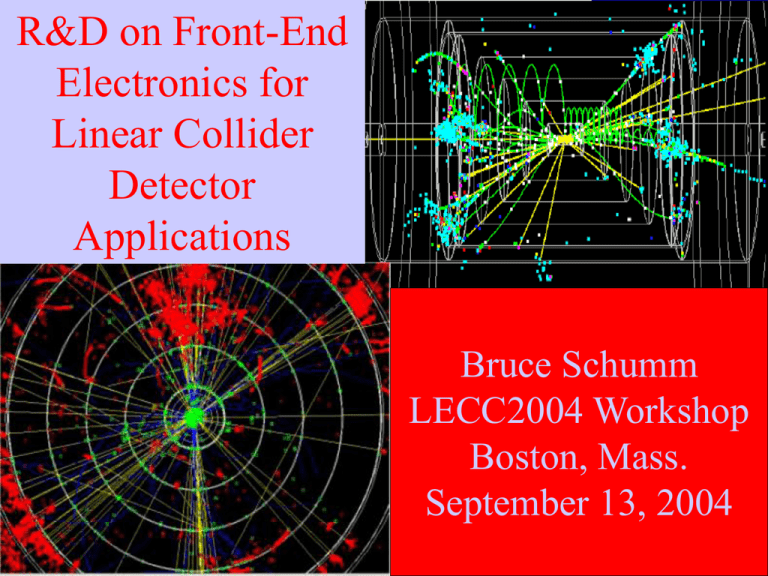
R&D on Front-End Electronics for Linear Collider Detector Applications Bruce Schumm LECC2004 Workshop Boston, Mass. September 13, 2004 TESLA Principle 1: The Linear Collider is not the LHC. LHC LC Ecm 14 TeV Ecm 0.5 TeV What the LC lacks in brute-force discovery reach, it must make up with finesse the LC requires a precision detector, and the electronics to instrument it. To understand the need for R&D on front-end electronics for the Linear Collider, it is essential to consider the physics one wants to do. By the way… the time frame for this R&D is surprisingly current Jae Yu, UT Arlington Linear Collider Physics Given what we have discovered so far, for high enough energy, this process will happen with greater than unit probability. Our current understanding is incomplete! e eW/Z WW+ W/Z e+ e We need something new to put in the circle. Here are some thoughts… THE HIGGS (h0) Haijun Yang, Michigan + Z0 LC Physics demands precise tracking Mrec for p/ p2= 3x10-5 (Solid state) Mass Recoiling against Z0 (Gaseous) Precision demands state-of-the-art central tracker resolution The LC must do more than just confirm LHC’s Higgs discovery. It must probe Higgs properties with the precision needed to detect subtle new physics scenarios (SUSY, Little Higgs, etc.) Model-independent branching fractions require unprecedented bottom and charm tagging ultraprecise threedimensional vertexing e eW/Z WW+ e+ Essential final-state discrimination must be done calorimetrically ‘Energyflow reconstruction’ places demands on calorimeter design If Higgs is just a fairy tale, then more exotic states must play a role ‘Strong WW Scattering’ W/Z e Henri Videau; Ecole Polytechnique E jet 0.60 E jet E jet 0.30 E jet Timing is Important T. Barklow Pileup of → hadrons for ~200 beam crossings Timing in Cal and Tracking Systems needs to be considered Pileup from 192 crossings (56 Hadronic Events) Pileup from 3 crossings So… what do we mean by ‘timing’? The Technology Choice Duty Cycle: 5x10-3 WARM: Short, intense spill (192 pulses separated by 1.4 ns), and often (120 Hz) And the choice is… COLD: Relaxed but persistent spill (2820 pulses separated by 337 ns); occasional (5 Hz) COLD Calorimetry The Energy-Flow Concept • Photons and high-energy electrons measured best with calorimetry (ECAL) • Charged hadrons measured best in tracker HCAL Separate clusters in calorimeter and decide what to hand back to tracker Requires ‘tracking calorimeter’ with minimal shower spread and maximal segmentation (Moliere radius of W is about 1 cm) The SD Si/W Group M. Breidenbach, D. Freytag, N. Graf, G. Haller, O. Milgrome Stanford Linear Accelerator Center R. Frey, D. Strom U. Oregon CALICE is a consortium of 28 institutions from 8 nations V. Radeka Brookhaven National Lab (TESLA TDR) Proposal for ECAL: • Thin Si diodes read out showers in W layers (Si/W) • Read out each layer with granularity given by Rmoliere (1 cm2) Challenge: This implies a few 107 channels 9720 channels in prototype Presentation of the front-end electronic (J. Fleury, LAL Orsay) 2 calibration switches chips 6 active wafers 6 calibration channels per chip Made of 36 silicon PIN diodes 18 diodes per calibration channel 216 channels per board Each diode is a 1cm² square Line buffers 12 FLC_PHY3 front-end chip To DAQ part 18 channels per chip Differential 13 bit dynamic range 14 layers 2.1 mm thick Made in korea (J. Fleury, LAL Orsay) Process: 0.8 m BiCMOS FLC-PHY3 Chip (LAL Orsay) Based on blocks from OPERA HPD readout ASIC Linearity Serial Noise (ENC) At ~200 nsec, Cdet in pF: ENC = 1720 + 28*Cdet (x1 gain) ENC = 950 + 34*Cdet (x10 gain) Now available for instrumentation of CALICE ECAL prototype (~2000 packages) Threads in ongoing ECAL front-end electronics Research and Development For precision calorimetry, compactness is important • Maintain Moliere redius • Calorimetry inside coil • Handle staggering channel count Multi-channel electronics integrated into detector volume Power cycling to avoid active cooling Zero-suppression, timing to avoid pile-up SD Si/W Ecal Concept (R. Frey, SD Si/W group) Wafer and readout chip (R. Frey, SD Si/W group) SD Si/W ASIC • Capacitance – Pixels: 5.7 pF – Traces and pre-amp: 22 pF • Resistance – 300 ohm max • Power – < 40 mW/wafer power cycling (An important LC feature!) • Signal Processing – Provide fully digitized, zero suppressed outputs of Q and T – One ASIC per wafer • Signals – <2000 e noise – Require MIPs with S/N > 7 – Max. signal 2500 MIPs (5mm pixels) Dynamically switched Cf Signals after 1st stage larger •0.1 mV → 6.4mV for MIP Much reduced power •Large currents in 1st stage only CALICE will pursue similar development Hadronic Calorimeter (HCAL) Need to maintain longitudinal and transverse segmentation: • 5x5 cm2 ‘Analog HCAL’ • 3x3 cm2 ‘Semi-digital HCAL’ • 1x1 cm2 ‘Digital HCAL’ Silicon Photomul- Moscow Engineering and Physics Institute tiplier (SiPM) Ganged Geigermode pixels SiPM Electronics Development SiPM signals: QE (%) gain 106: MIPs dyn range: fast: 1 photo electron = 160 fC ~ 25 p.e. = 4 pC Max signal = 400 pC few ns rise time pulse shape set by wavelength shifter fiber Quantum Efficiency similar to PMT, but single-stage gain, so better statistically than PMT or APD (singlePE statistics) SiPM noise: 2MHz noise rate (signal every 500ns) dominated by 1 pixel signals necessary calibration signal But could pile up with slow shaping SiPM calibration Felix Sefkow, DESY • The MIP signal determines the energy scale – monitor overall response • scint, SiPM, FEE • LED: inject UV into scintillator: – Single photon peak spacing a must! • non-linearity correction (together with MIP and universal response function) • gain monitoring: SiPM temperature sensitivity: Gain: 3%/K, Signal: 4%/K – Medium LED signals: stability between MIP calibration runs – Large LED signals: direct nonlinearity monitoring • Charge injection: electronics calibration Single photoelectrons MIP Linearity Two ShapingTime/Two Gain Solution Calibration mode (short shaping) Single photoelectron response Cf=0.2pF ; τ =12ns 1 spe = 8.9 mV ; tp=40 ns Noise : 720 µV rms Unipolar/Two Gain Solution (avoid overshoot that can lead to single PE pile-up) 3.5kΩ 5pF 11pF Physics mode (longer shaping) MIP (=16pe) response Cf=0.4pF ; Rc=5k ; τ =120ns Gain = 12 mV/MIP ; tp=186ns Noise = 570 µV rms + - 7kΩ 5.5pF 2.8kΩ Vref + OTA Calib switch Gm=1uA/V Both on same prototype ASIC; to be submitted ASIC for ‘Digital HCAL’ – 1 cm2 RPC’s Pick-up pads Graphite Signal HV Gas Resistive plates 64 inputs with choice of input gains RPCs (streamer and avalanche), GEMs… Triggerless or triggered operation Output: hit pattern and time stamp J. Repond, Argonne Analog circuitry taken from recently built FSSR chip (BTeV) Digital HCAL ASIC Hit catcher with possibility to mask noisy channels Chip has data indicator (essentially a fast OR) 10 MHz Clock Hope to submit by end of 2004 Tracking Gaseous Tracking in the Third Millennium A TPC event from Tracking in heavy ion collisions is STAR at RHIC messy, but TPC’s are highly pixellated For the Linear Collider Detector: • Track densities are actually higher • Baseline performance implies x3 improvement in point resolution • Must avoid excessive material in endcaps (energy flow into forward calorimetry X0(%) v. (deg) MICROMEGAS Traditional wire-plane readout too course Micro-Patterned Gas Detectors • Finer segmentation better resolution • Ion feedback into tracking volume is small if gain is kept low (~102 per layer) GEM TPC Electronics Issues Low Noise: want to keep gain low to avoid excessive feedback of ions into the drift volume Channel Count: 2mm2 pads (to achieve 100 m resolution) implies > 106 channels; if limited (350 m) transverse diffusion is exploited, would reach 108 Flash ADC: Exploiting longitudinal diffusion (z drift) resolution limit implies ~100 MHz sampling Signal Processing: Zero suppression, buffering, waveform processing, power cycling, etc. to keep electronics compact and material down Begin upgrade of STAR/ALICE FEL or… Jan Timmermans, Nikhef Jan Timmermans, Nikhef Jan Timmermans, Nikhef Readout microMegas detector with 55x55 m2 pixel MediPix chip Clear depiction of ionization path, -ray Optimal for pattern recognition, two-track separation, dE/dX But: Approaches 1010 channels!! Solid-State Tracking: the ‘Gossamer Tracker’ Concept What if the only material in the tracker was the minimum necessary thickness of Si? • No support structure • No cooling • No electronics and servicing • Thinner detectors towards lower radius No – pigs can’t fly. But… Shaping (s) Length (cm) 1 100 1 200 3 100 3 200 10 100 10 200 Noise (e-) 2200 3950 1250 2200 1000 1850 Simulations suggest that 3 s shaping time allows ladders to be read from end only no electronics servicing. Minimum-ionizing for 300m of silicon is about 24,000 electrons Operating point for 167 cm ladder ‘Just’ switch electronics off during these dead periods ~99% power savings; eliminates need for active cooling What about event pile-up in the tracker? t SNR Where SNR = signal-to-noise ratio. For = 3 s and SNR = 12, t 250 nsec Gossamer Tracker FEL Characteristics Need to develop a chip that… • Has low intrinsic noise Complementary efforts at: • Has long (several s) shaping • LPNHE Paris • Can switch power on/off in ~100 s • Analog readout (centroid, dE/dX) • Time stamping and pipeline • UCSC (SCIPP) Both targeting fall prototype run for example… Resolution (10-5 m) 167 cm ladder Resolution (10-5 m) 132 cm ladder RMS RMS Gaussian Fit Gaussian Fit 128 mip 1 mip ¼ mip Response to signals between ¼ and 128 mips (in factor-of-two octaves) 0.29 mip threshold Power Off Power On 60 sec pow restoration 8 msec power-off period (not to scale) Response to ¼, 1 and 4 mip signals Vertexing Global Baseline LC Vertex Detector 10 m 5 m Best yet (SLD) Proposed 1 m Optimistic projections achieved by very small (~20m x 20m) pixels and very thin (<0.1% X0) layers Thinned CCD’s But: transition from SLC to LC application is not immediate… Typical CCD sensor includes roughly ¼ million pixels and takes ~100msec to read out with a 5 MHz clock For the LC, this would integrate over the full train of 2,820 pulses, leading to intractable backgrounds Speed up and de-serialize readout Column-parallel CCD readout architecture Column-parallel CCD has been developed (E2V corporation) Readout scenarios under development Readout Chip CPR1 6 mm Wire/bump bond pads ASIC for CPC-1 readout Charge Charge Amplifiers Amplifiers Voltage Voltage Amplifiers Amplifiers design: RAL Microelectronics Group voltage amplifiers for 1-stage SF outputs 6.5 mm 250 2505-bit 5-bitflash flash ADCs ADCs charge amplifiers for direct outputs 20 μm pitch, 0.25 μm CMOS process 250(W)132(L)5-bit 250(W)132(L)5-bit FIFO FIFO Wire/bump bond pads wire- and bump-bondable scalable and designed to work at 50 MHz bump bonding performed by VTT (Finland) connecting to CCD channels at effective pitch of 20m possible by staggering of solder bumps Spectrum (55Fe) observed from voltage output (less aggressive) nodes; beginning to look promising BUT: in order to avoid event pile-up, you must read out the detector (many times over!) during the spill… Chris Damerell, Rutherford Labs (LCWS04) Store charge in 20 slices during ~1sec spill; read out between spills But is there a Plan B??!! Progress in Active Pixel R&D `Monolithic’ designs (electronics deposited directly onto sensors) – why? Typical current active pixel detector: • Large-pitch pixel sensor (~100 m or more) • Readout circuitry with fill-factor ~1 • Bump bonds • Servicing and cooling Does not achieve ideal impact parameter resolution due to pitch and material burden A number of different approaches are being explored… • MAPS (Monolithic Active Pixel Sensor) • FAPS (Flexible Active Pixel Sensor) • DEPFET (Depleted Field Effect Transistor) APS • SOI (Silicon on Insulator) APS Active Pixel Sensors (APS) Existing application in high-end digital photography; development for particle physics detection led by LEPSI electronics consortium at IRES Strasbourg. Basic idea: readout grown directly onto expitaxial layer of VLSI sensor; charge collected via diffusion through epilayer MIMOSA V: Proof of Principle Now under development: ‘MIMOSA STAR’ for use in STAR vertexing layers Similar to CCD’s, must go to faster, parallelized readout for Linear Collider increased on-pixel functionality • Sample-and-hold (switched capacitors) • Zero suppression • Addressable for column-parallel readout But deep submicron processes still promise attractive pitch, and active portion of device is intrinsically thin. DEPFET principle and properties DEPFET structure and device symbol Function principle – Field effect transistor on top of fully depleted bulk – All charge generated in fully depleted bulk; assembles underneath the transistor channel; steers the transistor current – Clearing by positive pulse on clear electrode – Combined function of sensor and amplifier Participants: MPI Munich, MPI Halle, Mannheim, gGmbH Munich, Bonn; material presented here due to Gerhard Lutz, MPI Munich DEPFET Matrix Read Out: ASICs Development at the Universities Bonn and Mannheim CURO II: 4.6 mm 4.5 mm Switcher II: 4.8 mm Readout row selection chip • AMS 0.8µm HV • high speed • high voltage range (20V) • 64 rows=2x64 channels • daisy chainable 4.5 mm Fast RO chip for DEPFETs • TSMC 0.25µm, 5 metal • 128 channels „CUrrent ReadOut“ • fast current based memory cells • hit identification + zero suppression • Correlated double sampling within 40ns DEPFET DEPFET STATUS Basic versions in use in XRAY astrophysics, medical imaging. 100 80 response Noise = 36,8nA 60 40 20 @ 24MHz Hybrid with CURO only in copper box 0 5 10 15 20 Itrim [DAC steps] 25 30 Switcher CURO II noise perfomance via threshold scan: 0 Switcher 35 For LC: time structure, precision demand faster frame rate, power cycling; prototype is really just proof-of-principle at this point. Silicon on Insulator (SOI) Detector Concept AGH Krakow, IET Warsaw,U. of Insubria (Como) Approach promises large signals since substrate is depleted; can use both NMOS and PMOS Group has observed signals (90Sr source) with correlated sampling But pixel size is large (150 x 150 m2) and integration time long Substantial R&D needed if technology is to be attractive for LC detector Summary LC detector development leading to many interesting R&D threads (with some interdisciplinary applications) Most initiatives unique to LC (precision, bunch structure, power cycling) Boundaries between detector and front-end electronics becoming obscured in some cases Timeline for baseline (500 GeV) LC is surprisingly short: we are in the midst of the R&D phase Next LC (machine) step: formation of International Design Group (IDG). Although far from certain, the LC is moving forward. EXTRA SLIDES Mimosa prototypes CHIP YEAR PROCESS EPITAXIAL PITCH m m METAL PECULIAR M1 1999 AMS 0.6 m 14 20 3M thick epitaxy M2 2000 MIETEC 0.35 m 4,2 20 5M thin epitaxy M3 2001 IBM 0.25 m 2 8 3M deep sub-m M4 2001 AMS 0.35 m 0! 20 3M low dop. Substrate SUC 2 2003 AMS 0.35 m none 40 3M low dop. Substrate (SUCIMA project) M5 & M5B 2001/2003 AMS 0.6 m 14 17 3M real scale 1M pixels M6 2002 MIETEC 0.35 m 4,2 28 5M col. // r.o. and integrated spars. M7 M8 M9 SUC 1 2003 2003 2004 AMS 0.35 m TSMC 0.25 m AMS 0.35 m none 8 20 25 25 20/30/40 4M 5M 4M col. // r.o. and integ. spars. (photoFET) col. // r.o. and integrated spars. opto. tests diodes/pitch/leakage current. irradiation tests Variable Shaping-Time / Variable Gain ASIC 100MΩ 8-bit 40kΩ 0.1pF 0.2pF DAC 1-5V 1.2pF 0.4pF 0.6pF 0.8pF 0.3pF in 50Ω 2.4pF ASIC 12kΩ 4kΩ 10pF 5kΩ 8pF 4pF 2pF 1pF 24pF 12pF 6pF 100n F Test_pulse Variable Gain Charge Preamplifier From L.Raux 3pF Technology: Variable Shaper CR-AMS 0.8 m CMOS RC²
